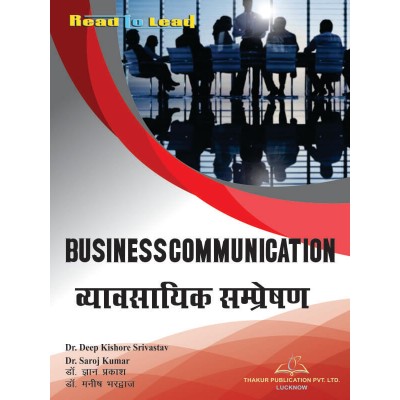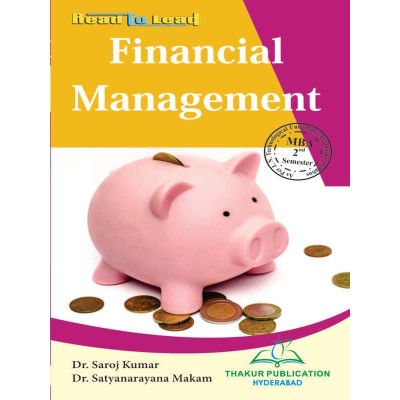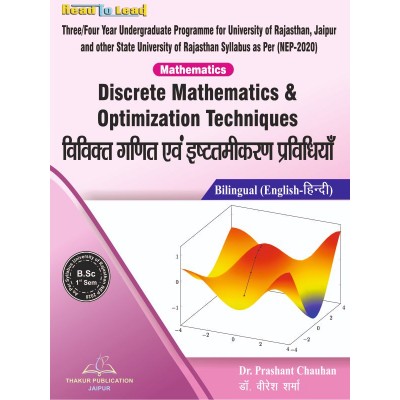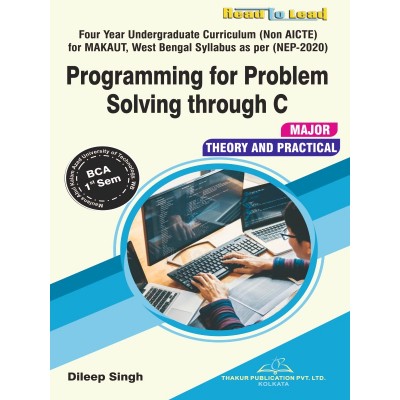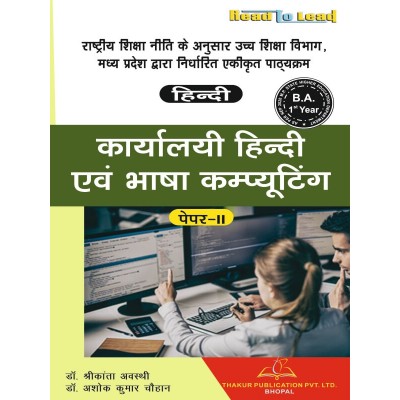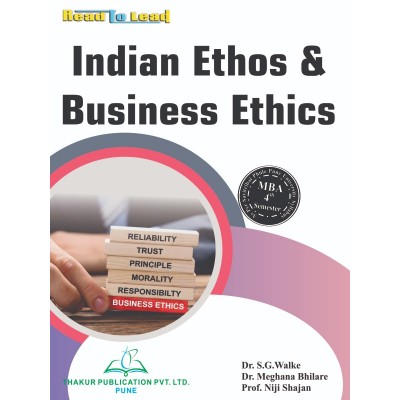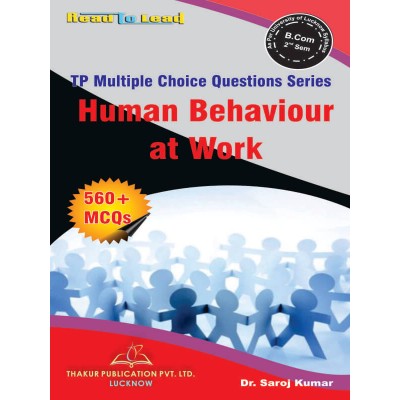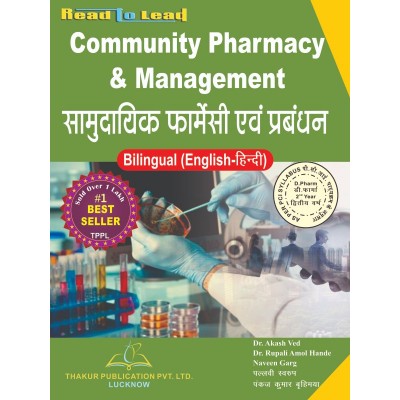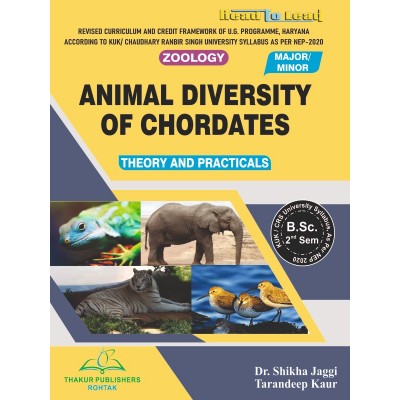Categories
- Pharmacy
-
Nursing
-
MBA
-
BBA
- U.P. State University
- Veer Bahadur Singh Purvanchal University, Jaunpur
- Chaudhary Charan Singh University, Meerut
- Dr. Bhimrao Ambedkar University, Agra
- Chhatrapati Shahu Ji Maharaj University, Kanpur
- Mahatma Jyotiba Phule Rohilkhand University, Bareilly
- Mahatma Gandhi Kashi Vidyapith, Varanasi
- Dr. Ram Manohar Lohia Avadh University, Ayodhya
- Deen Dayal Upadhyaya Gorakhpur University
- Prof. Rajendra Singh (Rajju Bhaiya) University, Prayagraj
-
BCA
- UP State Universities
- University of Pune
- I.K.Gujral Punjab Technical University (PTU)
- University of Rajasthan
- Rashtrasant Tukadoji Maharaj Nagpur University
- Uttar Pradesh NEP2020
- University of Rajasthan ,Jaipur (According to NEP-2020)
- BCCA (B. Com - Computer Science)
- Haryana
- West Bengal
- BBA (CA)
- PUNE BCA (Sci,Commerce)/B.Com (CA)
- Dr. A. P. J. Abdul Kalam Technical University, Lucknow ( AKTU )
- MCA
-
B Ed
- Lucknow University B.Ed Books
- Chaudhary Charan Singh University/Maa Shakambhari University, Saharanpur
- Dr Bhim Rao Ambedkar University, Agra
- Mahatma Gandhi Kashi Vidyapeeth, Varanasi
- Chhatrapati Shahu Ji Maharaj University
- Prof. Rajendra Singh (Rajju Bhaiya) University, Prayagraj (PRSU)
- Mahatma Jyotiba Phule Rohilkhand University(Mjpru), Bareilly
- Dr. Ram Manohar Lohia Avadh University, Ayodhya
- Bundelkhand University, Jhansi
- B.A,B.ed
- B.Sc, B.ed
- Deen Dayal Upadhyaya Gorakhpur University
- Veer Bahadur Purvanchal University (VBPU)
- Maharaja Suhel Dev State University ,Azamgarh (MSDSU)
- Raja Mahendra Pratap Singh State University, Aligarh (RMPSSU)
- Barkatullah Vishwavidyalaya (Bhopal)
- Jiwaji University (Gwalior)
- Vikram University (Ujjain)
- Dr. Harisingh Gour University (Sagar)
- Devi Ahilya Vishwavidyalaya (Indore)
- Rani Durgavati Vishwavidyalaya (Jabalpur)
- Awadhesh Pratap Singh University (Rewa)
- Maharaja Chhatrasal Bundelkhand University (Chhatarpur)
- D. EL. ED
- TET
-
B Com
-
B Sc
- B.Sc. U.P. State Universities Common Syllabus NEP
- Veer Bahadur Singh Purvanchal University, Jaunpur
- University of Lucknow
- Chaudhary Charan Singh University, Meerut
- Madhya Pradesh
- Chhatrapati Shahu Ji Maharaj University, Kanpur
- Dr. Bhimrao Ambedkar University, Agra
- Mahatma Gandhi Kashi Vidyapith, Varanasi
- DEEN DAYAL UPADHYAYA GORAKHPUR UNIVERSITY
- Prof. Rajendra Singh (Rajju Bhaiya) University, Prayagraj
- Dr. Ram Manohar Lohia Avadh University, Ayodhya
- Mahatma Jyotiba Phule Rohilkhand University, Bareilly
- Uttarakhand State Universities
- B.Sc. Bihar Universities Common Syllabus NEP
- University of Rajasthan (Jaipur)
- Haryana
-
Bachelor of Arts [B.A.]
- B.A. Of U.P. State Universities Common Syllabus NEP
- Veer Bahadur Singh Purvanchal University, Jaunpur
- University of Lucknow
- Chaudhary Charan Singh University, Meerut
- Chhatrapati Shahu Ji Maharaj University, Kanpur
- Dr. Bhimrao Ambedkar University, Agra
- Mahatma Gandhi Kashi Vidyapith, Varanasi
- Deen Dayal Upadhyaya Gorakhpur University
- Prof. Rajendra Singh (Rajju Bhaiya) University, Prayagraj
- Dr. Ram Manohar Lohia Avadh University, Ayodhya
- Mahatma Jyotiba Phule Rohilkhand University, Bareilly
- Madhya Pradesh
- Uttarakhand
- Bihar
- University of Rajasthan (Jaipur Syllabus as Per NEP2020)
- Haryana NEP-2020
- B Tech
- LLB
- SWA Education
CHEMISTRY-II B.Sc 2nd Semester KUK/CRS University
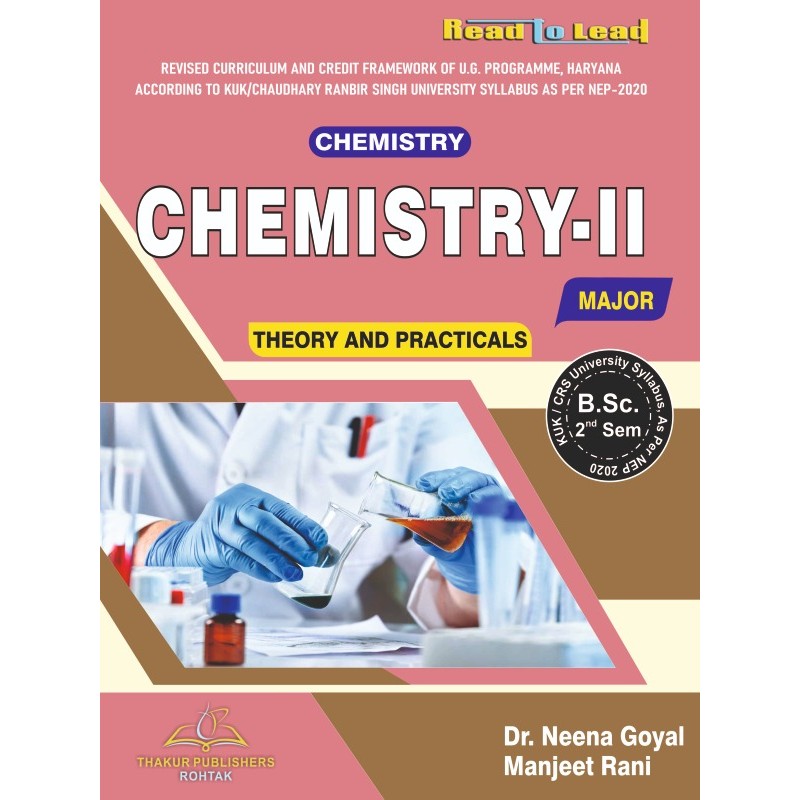
Buy Latest CHEMISTRY-II (MAJOR) Book in English Language for B.Sc 2nd Semester KUK/CRS University NEP-2020 By Thakur Publication.Written by Experienced Authors | Fast & All India Delivery |
AUTHOR: Dr. Neena Goyal, Mrs. Manjeet Rani
ISBN : 978-93-5755-558-6
Tax excluded
Buy Latest CHEMISTRY-II (MAJOR) Book in English Language for B.Sc 2nd Semester KUK/CRS University NEP-2020 By Thakur Publication.Written by Experienced Authors | Fast & All India Delivery |
AUTHOR: Dr. Neena Goyal, Mrs. Manjeet Rani
ISBN : 978-93-5755-558-6
Syllabus
Chemistry-II
Course Code: B23-CHE-201
|
Unit |
Topic |
Contact Hours |
|
I |
Covalent Bond Valence bond theory approach, shapes of simple inorganic molecules and ions based on valence shell electron pair repulsion (VSEPR) theory and hybridization with suitable examples of linear, trigonal planar, square planar, tetrahedral, trigonal bipyramidal and octahedral arrangements. Molecular orbital theory of homonuclear (N2, O2) and heteronuclear (CO and NO) diatomic molecules, dipole moment and percentage ionic character in covalent bond.
Ionic Solids Ionic structures (NaCl, CsCl, ZnS (Zinc blende), CaF2) size effects, radius ratio rule and its limitations, Concept of Lattice energy, Born- Haber cycle, Solvation energy and its relationship with solubility of Ionic solids, Polarizing power and Polarisability of ions, Fajan’s rule. |
11 |
|
II |
Chemical Kinetics Concept of reaction rates, rate equation, factors influencing the rate of reaction, Order and molecularity of a reaction, integrated rate expression for zero, first, Half-life period of a reaction, Arrhenius equation.
Distribution Law Nernst distribution law – its thermodynamic derivation, Nernst distribution law after association and dissociation of solute in one of the phases, of distribution law: (i) Determination of degree of hydrolysis and hydrolysis constant of aniline hydrochloride |
12 |
|
III |
Alkanes and Cycloalkanes Nomenclature, classification of carbon atoms in alkanes and its structure. Isomerism in alkanes, sources. Methods of formation: Wurtz reaction, Kolbe reaction, Corey- House reaction and decarboxylation of carboxylic acids, physical properties. Mechanism of free radical halogenation of alkanes: reactivity and selectivity.
Nomenclature of Cycloalkanes, Baeyer’s strain theory and its limitations, theory of strainless rings.
Alkenes Nomenclature of alkenes and its structure. Methods of formation: dehydration of alcohols, dehydrohalogenation of alkyl halide, Hofmann elimination and their mechanism. The Saytzeff rule and relative stabilities of alkenes. Chemical reactions: electrophilic and free radical additions, addition of halogens, halogen acids, hydroboration–oxidation, oxymercuration-reduction, ozonolysis and hydration. Markownikoff’s rule of addition. |
11 |
|
IV |
Hydrogen Bonding and Van der Waals Forces Hydrogen Bonding – Definition, types, effects of hydrogen bonding on properties of substances, application Brief discussion of various types of Van der Waals forces.
Metallic Bond and Semiconductors Metallic bond – Qualitative idea of valence bond and Band theories of metallic bond (conductors, semiconductors, insulators).
Semiconductors – Introduction, types, and applications. |
11 |
|
V* |
1. Complexometric Titrations: Determination of Mg2+ by EDTA. 2. Paper Chromatography: Qualitative Analysis of any one of the following Inorganic cations and anions by paper chromatography (Pb2+, Cu2+, Ni2+, Cl–, Br–, and and ). 3. To determine the viscosity of given liquid using Ostwald’s Viscometer. 4. To determine the specific refractivity of at least two liquids by Refractometer. 5. Separation of mixture of two organic compounds by TLC. |
30 |
16 other products in the same category:
Your review appreciation cannot be sent
Report comment
Report sent
Your report cannot be sent
Write your review
Review sent
Your review cannot be sent









